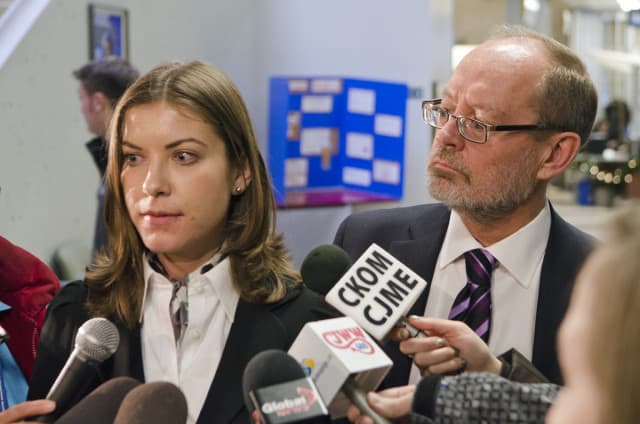DARYL HOFMANN & BRYN BECKER

Julie Kryzanowski, deputy medical health officer for the Saskatoon Health Region, and David Hannah, vice-president student affairs, addressed the media in a press conference this afternoon at Student Central.
A student enrolled in arts and science classes has tested positive for active tuberculosis and 589 of his or her classmates and professors may have been exposed to the airborne disease.
The Saskatoon Health Region released the information to the University of Saskatchewan community Nov. 30 in an email saying that “the risk of infection to other students, faculty and staff who have not been in close contact is low, so there is no cause for alarm.”
The nearly 600 individuals who shared a class with the student this semester were sent a separate email that provided basic information on TB and urged them to attend a temporary testing clinic set up in the Education Building from Dec. 3 to 6.
The email warned that the student infected with TB was in one of their classes but did not specify which particular class.
“We are working to ensure that all students who may have been exposed are offered testing for tuberculosis disease and we will follow with those students as appropriate,” said Julie Kryzanowski, deputy medical health officer for the Saskatoon Health Region, during a press scrum in the administration building Nov. 30.
The risk of spreading TB depends on the proximity and timeframe of contact with an active case.
People who breathe air containing the bacteria have a chance of becoming infected. Once infected, for most healthy people, the bacteria does not become active and does not make them sick.
The student who has been infected and fallen ill, whose personal information is being kept under tight wraps to protect privacy, did not live on campus and it is not expected that they picked up the disease while at the university.
The student is currently undergoing treatment and is “doing well,” Kryzanowski said.
Testing for TB is done through the skin. The test requires that any potentially infected students attend a clinic twice.
“They attend the clinic the first day and that’s when they are injected with the tuberculin skin test antigen. Then they would come back to the clinic 48 hours later to have the test read,” Kryzanowski said.
If an individual is infected with TB and tests positive, they will be administered a six-month dose of antibiotics.
Cody Hoffmann, a first-year arts and science student, was informed that he was potentially exposed to the disease when his History 110 professor told his class to go get tested. Hoffmann believes the university is handling the situation well but said he’s just too busy to go in for a test as final exams loom.
“Of course finals are upon us so I decided not to get tested since it takes a great deal of effort in between studying to make two trips to the Education Building gym 48-hours apart,” he wrote to the Sheaf.
TB is a bacterial infection of the lungs and is typically spread through coughing, sneezing, spitting and even speaking in close-quarters.
According to David Hannah, U of S associate vice-president of student affairs, this is the first time TB — or any infectious disease for that matter — has been reported at the university in at least 11 years.
“From what we have heard the risks are minimal but there is a risk there. So we are really encouraging anybody who’s received the letter we have sent, students who were in the same classes with the infected student, to please get tested next week,” Hannah said.
Anyone concerned that they have contracted TB but did not receive an email can be tested as well, Hannah said.
Saskatchewan Tuberculosis Control, based out of the Royal University Hospital, is investigating the case to determine where the disease was caught.
In 2010, Saskatchewan had 80 known cases of TB, 60 of which were in the northern region of the province.
—
Photo: Bryn Becker/The Sheaf